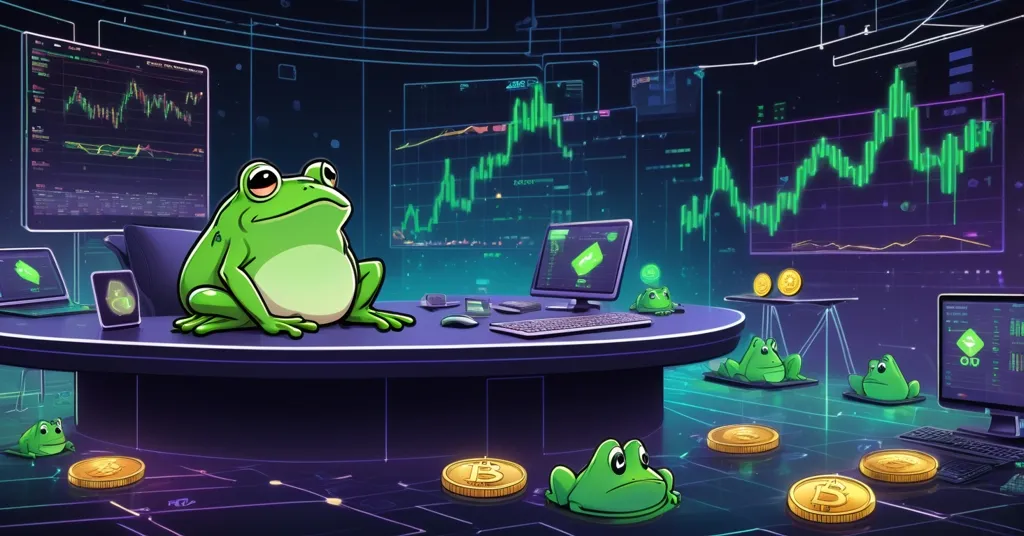BlockchainFX ($BFX) Presale Sparks Buzz as Pepe Coin Hype Fades in 2025 Crypto Market

Pepe Coin Hype Fading? BlockchainFX ($BFX) Presale Emerges as Top 2025 Crypto Pick
The crypto market in October 2025 is a chaotic playground of opportunity and risk, with meme coins like Pepe (PEPE) losing steam after their viral surges, while new projects like BlockchainFX ($BFX) spark fresh excitement with a presale that’s turning heads. As Bitcoin continues to anchor the space with its unyielding dominance, altcoins are carving out wild price swings, and investors are hungry for the next big score.
- Pepe’s Waning Spark: Once a meme coin darling, has its millionaire-making run come to an end?
- BlockchainFX ($BFX) Buzz: A presale for a “crypto super app” promising utility and massive gains.
- Hype vs. Hard Truths: Navigating the promises and pitfalls of $BFX and late-stage meme coin plays.
Pepe’s Rise and Fall: A Meme Coin Cautionary Tale
Pepe (PEPE) started as a joke—a quirky frog meme turned digital asset that few took seriously. Yet, powered by viral hype on platforms like Twitter and Reddit, it exploded into a cultural phenomenon, minting millionaires out of early investors who dared to bet on absurdity. Community fervor drove its value skyward, with stories of overnight wealth fueling a classic case of FOMO (fear of missing out). By Q4 2025, though, the buzz seems to be fizzling. Trading volumes—hypothetically speaking, given the future setting—appear to be dipping, and online chatter suggests meme coin fatigue among retail investors. Oversaturation in the meme coin market, with countless copycats flooding exchanges, might be diluting Pepe’s once-unique appeal.
Analysts still throw around optimistic price predictions for Pepe in 2025, hinting at lingering relevance for die-hard fans. But let’s not kid ourselves—jumping into a fading pump is a recipe for disaster. Latecomers often end up holding worthless tokens when the hype train derails. Pepe’s story is less about sustainable value and more about the raw, chaotic energy of crypto’s lawless frontier, where fortunes are made and lost overnight. It’s a reminder that community-driven tokens, while entertaining, rarely offer the fundamentals needed for long-term staying power. So, is Pepe still worth buying in 2025? Probably not, unless you’ve got a crystal ball and nerves of steel.
BlockchainFX ($BFX): Utility or Hype Machine?
While Pepe’s viral flame dims, BlockchainFX ($BFX) is stoking a different kind of fire—one built on the promise of utility over memes. Currently in presale in October 2025, $BFX markets itself as a “crypto super app,” a platform aiming to merge trading of multiple asset classes—cryptocurrencies, stocks, forex, and commodities—into a single hub. This isn’t just another speculative token, according to its pitch. It’s a revenue-generating ecosystem with over 10,000 daily active users and millions in reported trading volume, claiming to bridge decentralized finance (DeFi) with traditional markets. For more insights on this trending presale, check out details on BlockchainFX’s potential as a top crypto pick.
Let’s unpack the presale details. Starting at $0.01, the token price has climbed to $0.027, with a confirmed launch price of $0.05. Over $9 million has been raised from more than 13,400 buyers, and price hikes are scheduled every Monday to keep the urgency dialed up. If you’re considering a stake, here’s the math broken down simply:
- A $50,000 investment at $0.027 buys roughly 1.85 million $BFX tokens.
- At launch ($0.05), that’s worth about $92,592—a neat 85% gain.
- If analyst dreams of a $1 target come true, you’re sitting on $1.85 million. Big if, though.
Beyond price speculation, $BFX dangles some enticing perks. Holders are promised up to 70% of the platform’s trading fees, redistributed daily in USDT, with returns hyped at 4–7% per day. During presale, they’re boasting an Annual Percentage Yield (APY)—a measure of expected yearly returns—of up to 90%. There are also BFX Visa cards for global crypto spending, bonus codes like “BLOCK30” for 30% extra tokens, a 10% referral bonus in $BFX, and a $500,000 giveaway to sweeten the deal. On paper, it sounds like a dream for investors frustrated by fragmented financial systems.
But how does $BFX stack up against the competition? Compared to giants like Binance, which already offers multi-asset trading, or decentralized platforms like Uniswap, focused purely on crypto swaps, $BFX’s ambition to integrate traditional assets with blockchain tech is bold. Yet, it’s not without hurdles. Technical challenges—like ensuring seamless cross-asset trading on-chain—and regulatory minefields, especially around securities laws for stocks and forex, could trip up even the most well-intentioned project. Whether $BFX can deliver isn’t just a question of coding; it’s a gamble on navigating a hostile legal landscape.
Red Flags and Reality Checks
Now, let’s cut the shiny brochure nonsense and face the ugly side. Promises of 4–7% daily returns and a 90% APY during presale? That reeks of a cash grab designed to fleece eager investors before the inevitable crash. If that doesn’t scream unicorn-level fantasy, I don’t know what does—but hey, stranger things have happened in crypto. Historically, such sky-high yields often signal a Ponzi-like setup, where early investors are paid with later ones’ money until the whole house of cards collapses. Sustainability is the key word here, and $BFX’s numbers don’t pass the smell test.
Presale investments are a notorious gamble in this space. For the uninitiated, a “rug pull” is when developers hype a project, collect funds, and then vanish, leaving investors with worthless tokens. Liquidity issues—where there aren’t enough buyers post-launch to sell your tokens at a decent price—are another trap. Then there’s the risk of unfulfilled promises; many projects fail to deliver the features they tout. The fact that $BFX’s promotion seems tied to sponsored content, often with disclaimers from hosting platforms, only heightens the need for caution. We’ve seen this playbook before—hype now, dump later.
On the credibility front, $BFX waves a CertiK audit and full KYC (Know Your Customer) compliance as proof it’s legit. CertiK is a respected blockchain security firm that audits smart contracts for vulnerabilities, a baseline for trust in crypto. KYC means the team has verified identities with regulators, which can deter outright fraud. But neither is a silver bullet. Scammers have passed audits before, and KYC doesn’t stop mismanagement or overblown promises. If you’re eyeing this presale, tread lightly. Community feedback—hypothetically, as we’re in 2025—on forums might offer more clues, but always dig beyond the marketing gloss.
Altcoins in the Crypto Revolution: Filling the Gaps
As Bitcoin maximalists, we at Let’s Talk, Bitcoin hold BTC as the gold standard of decentralization—a peer-to-peer currency that doesn’t need flashy promises to prove its worth. Bitcoin doesn’t dangle daily returns; it delivers unshakable freedom from centralized control. But we’re not blind to the gaps it leaves. BTC isn’t built for day-to-day trading of stocks or forex, nor does it aim to be. Ethereum dominates DeFi with smart contracts, and Solana pushes scalability, yet neither fully bridges traditional and decentralized finance in one neat package. This is where altcoins like $BFX try to stake their claim.
If $BFX delivers even a sliver of its vision—a unified platform for multi-asset trading—it could onboard users who’ve never touched Bitcoin but crave a taste of financial disruption. That aligns with our push for effective accelerationism, speeding toward tech that reshapes the world. But distraction is a real concern. Do projects like this dilute focus from Bitcoin’s core mission, or do they expand the tent, eventually funneling users to BTC as a store of value? It’s a debate worth having. For now, the 2025 market context—let’s assume a bull run with regulatory scrutiny tightening—will test whether utility-driven altcoins can withstand macro pressures like inflation or SEC crackdowns.
What’s Next for Crypto Hype Cycles?
The tug-of-war between innovation and skepticism defines crypto, and stories like Pepe and $BFX embody that struggle. Meme coins tap into raw emotion and virality, while presale projects dangle utility as the next frontier. Both feed on the same investor hunger for the “next big thing.” But for every breakout, there’s a graveyard of forgotten tokens. We’re all for pushing boundaries and empowering users through decentralization, but not by swallowing every slick pitch that lands in our inbox. Will $BFX be the bridge between DeFi and traditional finance, or just another shiny distraction? Only time—and a healthy dose of doubt—will tell.
Note: Investing in crypto presales carries extreme risk. Never invest more than you can afford to lose.
Key Takeaways and Questions to Ponder
- What drove Pepe’s meteoric rise as a meme coin?
Pepe surged on viral community hype through social media, turning early investors into millionaires despite its joke status, though its momentum now seems to be fading. - How does BlockchainFX ($BFX) stand apart from meme coins like Pepe?
Unlike Pepe’s speculative frenzy, $BFX pitches itself as a utility platform for trading multiple assets, with daily rewards and real-world perks like Visa cards. - Are $BFX’s promised returns realistic?
Claims of 4–7% daily returns and 90% APY are wildly speculative and often unsustainable, signaling high risk despite audit credentials. - What dangers lurk in presale investments like $BFX?
Presales are prone to rug pulls, liquidity shortages, and unmet promises, especially with sponsored hype amplifying the need for caution. - Do utility-focused altcoins have a role in crypto’s future?
Yes, they can fill niches Bitcoin and Ethereum don’t address, but only if they prove real value—$BFX’s outcome remains uncertain. - How do meme coins like Pepe affect Bitcoin’s dominance?
They draw attention and new users to crypto but often distract from Bitcoin’s core mission of decentralization with short-lived hype. - What should investors look for in a credible crypto presale?
Seek transparent teams, realistic promises, active communities, and independent audits—but even then, treat every presale as a high-stakes gamble.



